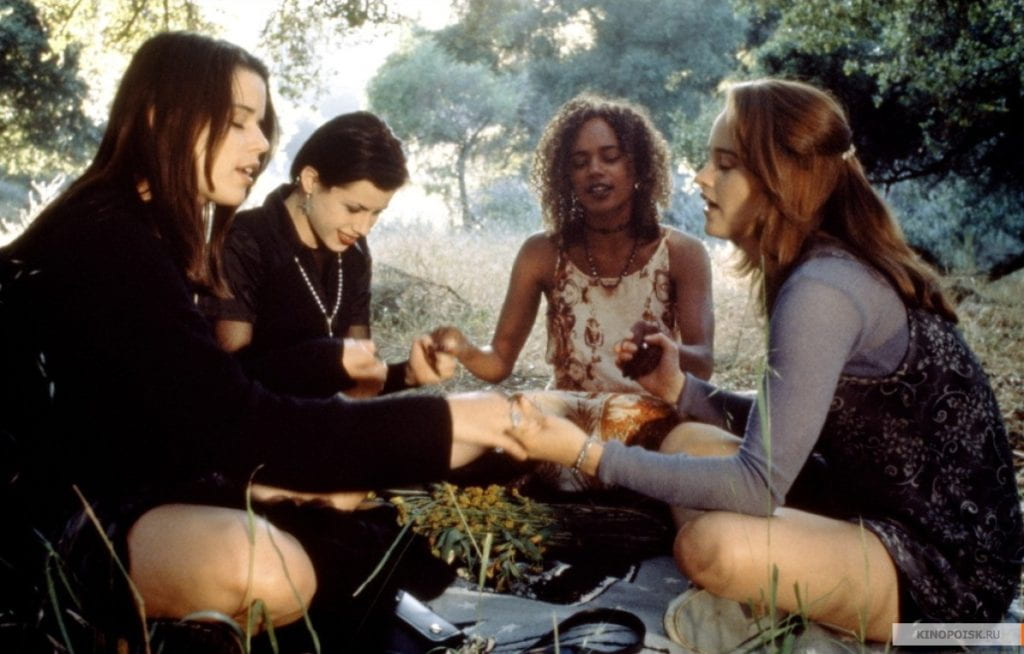
We are the weirdos, mister.
This sentence has been etched into enamel pins and posted thousands of times as a GIF on Twitter, Instagram, and Tumblr. For some, the line is just an iconic saying from some mid-1990s film, but for so many it’s one of the lines that cements their love and adoration for the teen witch drama The Craft. I first saw the film as a teenager myself before I ever saw the line and GIF appear online. While I think it is a fitting line to give non-viewers a peek into what this film is all about, it only scratches the surface of the thrills and chills the story delivers. It’s easy to reduce The Craft to a witchcraft-lite teen film, but in doing so you’d be missing out on so many layers of the story: complex female friendships, the price of vengeance, bullying in high school, slut shaming.
The movie begins with the arrival of Sarah (Robin Tunney), a girl that has just moved to Los Angeles and quickly finds a place amongst the outcasts in her Catholic preparatory school. The group consisting of Rochelle (Rachel True), Bonnie (Neve Campbell), and Nancy (Fairuza Balk) are self-proclaimed witches looking for a fourth member for their coven in order to complete their circle, and they believe that fourth could be Sarah. After spending more time with the group, though, Sarah is reluctant to join their coven and seeks out a relationship instead with one of the popular jocks. That relationship quickly sours, though, and she finds kinship with the coven again. While those on the outside see only girls with no social capital and little power, inside the coven they each see more than that. Before magic comes into the equation, there is still power in the group; they feel for each other, listen to each other’s problems, and see beyond who each person is now at this current moment.
There are plenty of memorable scenes, outfits, and dialogue from the film. While I remain slightly obsessed with getting the blue overalls Sarah wears about midway through the film and can talk forever about the iconic new uniforms they wear once they come into their full powers, I want to discuss one scene in more detail. One of my favorite moments will always be when all four girls decide to play “light as a feather, stiff as a board.” The magic used isn’t serious, life-altering magic — after all, it’s just a game so many kids have played before them. While their results may be better than most, at the end of the scene they are ultimately just girls reveling in being together and having this friendship. Their lives or social situations at school have not changed yet, but they don’t care right now, they are just having fun. It’s easy to say what ties them together is just their quest for magic and witchcraft, but it’s not that simple. The film’s intensity ramps up when the friendships start to deteriorate, the power beginning to separate them. Once they start relying on it more than each other, there’s a real destruction of harmony within the group.

I don’t think the film’s message is that power inherently ruins people, it’s more about the balance of power and how we use it. When Rochelle gets her first wish, she decides to enact some vengeance on a racist bully on the swim team, but later after seeing the effects of her spell, she has regrets. Everyone in the coven is still growing and learning, but with the combination of their youth and this power, they become a little too triggerhappy with how they use it. There are limits to everything, a lesson each girl learns as the film progresses — although some test the limits more than others and do incur repercussions.
The ending of the film is filled with special effects, a terrific fight scene, and a reversal of fortune. While I won’t reveal the outcome, I will say for those uninitiated into The Craft fandom that the last shot is almost as iconic as that previously mentioned GIF.
The Craft will be screened at IU Cinema on December 11 as part of the Study Break Mega Marathon.

Noni Ford is a freelance writer based in the Midwest and a graduate of the Indiana University Media School. She’s worked in voice coordination, independent film, and literary management, and primarily writes film criticism and short stories.